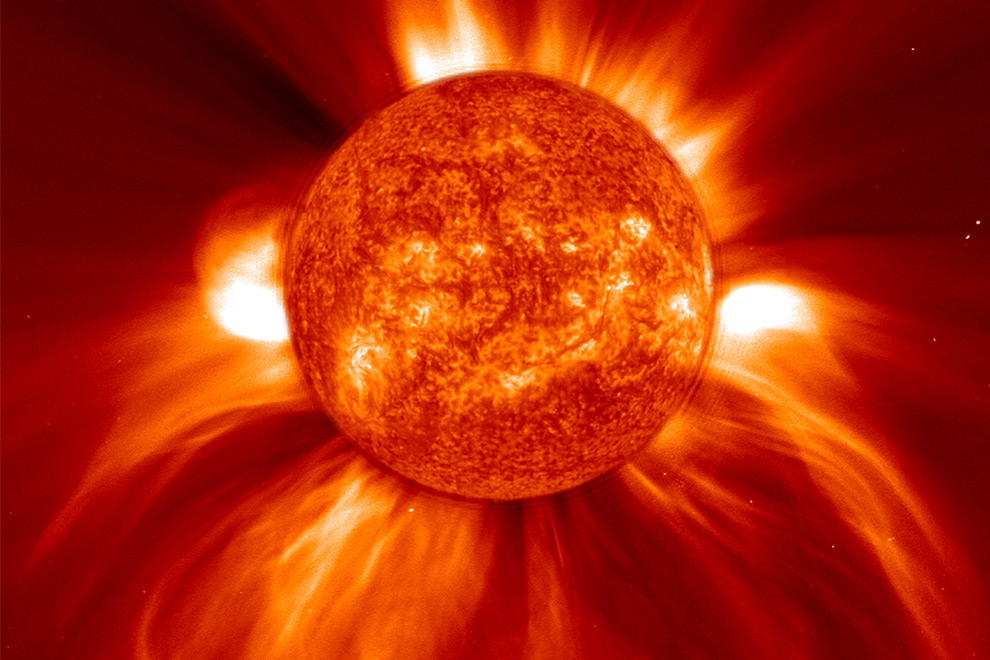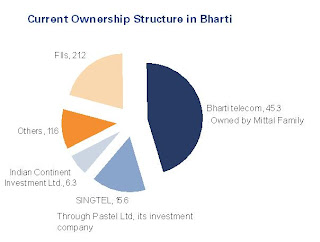This blog is about my reflections on my pursuits in life on variety of topics from Business and Finance, Technology, Economics, Philosophy, Science etc.. I would really appreciate if you visit my blog and post your comments in case you like any idea....
Sunday, November 8, 2009
Unsung innovators
http://images.businessweek.com/ss/09/04/0409_unsung_innovators
Friday, October 9, 2009
Google Strategy
Wednesday, October 7, 2009
Unbelievable Images of Sun
 Courtesy: Boston global
Courtesy: Boston globalAmazing images of solar activity taken from SOHO/ NASA solar telescopes...
"A sweeping prominence, a huge cloud of relatively cool dense plasma is seen suspended in the Sun's hot, thin corona. At times, promineces can erupt, escaping the Sun's atmosphere. Emission in this spectral line shows the upper chromosphere at a temperature of about 60,000 degrees K (over 100,000 degrees F). Every feature in the image traces magnetic field structure. The hottest areas appear almost white, while the darker red areas indicate cooler temperatures. (Courtesy of SOHO/EIT consortium) "
Google goes greener
A startling fact about Google searches has been revealed:
"Performing two Google searches from a desktop computer can generate about the same amount of carbon dioxide as boiling a kettle" or about 7g of CO2 per search. We are happy to make clear that this does not refer to a one-hit Google search taking less than a second, which Google says produces about 0.2g of CO2, a figure we accept. In the article, we were referring to a Google search that may involve several attempts to find the object being sought and that may last for several minutes. Various experts put forward carbon emission estimates for such a search of 1g-10g depending on the time involved and the equipment used.
This article also describes that Google is cautious about its energy consumption and carbon footprint. It also refuses to disclose the locations of its data centers.
Gartner Inc. has predicted that the cost of supplying energy to a server over its three-year lifetime will soon exceed the server’s acquisition cost. In the years to come the strategy for the biggies like Microsoft, Google, IBM and Yahoo would differentiate their service offering by providing efficient and greener
Google is taking steps towards reducing its carbon foot print by:
- focus on working towards a goal of making electricity from renewable sources cheaper than from
coal (RE
- Reconsidering business continuity plans
- Improving the power efficiency of their data center operations by
o Raise the temperature and humidity.
o Power reduction in facilities in the data center in cooling(typical chiller systems are only 60% efficient; Google has gotten to 90% by employing evaporative cooling
Source: searchdatacenter.techtarget.com
Typical metric for measuring the power efficiency of a data center is Power Utilization Efficiency (PUE) which measured as follows:
PUE = Total Facility Power/IT Equipement Power
Most contemporary data centers are in the 2.0-2.5 range – for every watt of power that a server uses to compute, they burn more than a watt in transmission loss, battery loss and cooling. Google is at 1.19 and Yahoo is targeting 1.03 in its next-gen data centers.
Water-based
As a step towards furthering its efforts to achieve a goal of making electricity from renewable sources cheaper than from coal, was granted a patent on an innovative method of water-based data center. The original patent filed can be found here.
Here are the details:
Invented by Jimmy Clidaras, David W. Stiver, and William Hamburgen
Assigned to Google
Granted: April 28, 2009
Filed February 26, 2007
Some of the factoids about this patent are:
1) The data center will be mounted on a floating platform in the sea and powered by sea based electrical systems. The electrical systems that may be used would be similar to wave/tide power generators such as Pelamis machines. These generators work on the principal of artificially generated waves/tides in the vicinity of the data center to generate the power.
2) All systems will be contained in standard shipping containers and would be connected to the electrical and cooling systems. This concept has come from Google’s earlier filed patent and granted on modular data centers. The original patent you can find here.
3) Other power sources such as sea-based wind generator farms and power from river currents have also been suggested in the patent.
Given some of the challenges companies like Google, Microsoft and Yahoo face such as:
- Physical space
- Operating expenses
- Security and reliability
- Thermal/Power management
It has become a matter of paramount important that companies innovate in a manner to differentiate in the market place and reap possible benefits from such approaches in the years to come.
Saturday, October 3, 2009
Effects of economic downturn

Friday, October 2, 2009
Microblogging evolutions..

The Deal
This is a bit complicated deal to understand. Lets try to guage what is the deal structure

Bharti would get 36% share in MTN from MTN shareholders by two means.
-
 It will pay for this in two parts- a cash portion of 86 Rand (US$10.34) per share totaling US$7.03 billion
It will pay for this in two parts- a cash portion of 86 Rand (US$10.34) per share totaling US$7.03 billion- and half a freshly issues Bharti shares for every MTN share it gets (about 34 Crore shares worth roughly $6.2bn as at Friday’s 22nd May 2009 market share price)
While MTN would eventually get 25% share in Bharti post merger by paying in two parts:
- US$2.89bn in cash
- and fresh issue of MTN share to Bharti equivalent of 25% of MTN existing equity (worth US$7bn)
At the end of this deal, Bharti would hold 49% in MTN while MTN will hold roughly 36.4% of
Bharti. Post merger the share holding in Bharti would look somthinlike this
(Source: Business India)

Bharti would issue in this case GDR which would be listed in Johannesberg Stock exchange. The deal had a complication that South African government had called for a dual listing of the merged entity. What this would mean is that the entity will be listed in Primary Market in India and South Africa and the shareholders of the company will be able to trade in both the markets. This would not only require current account convertability but also capital account convertability to make this happen.
For that to take place, significant changes will have to be made in Indian law and in the Foreign Exchange Management Act, and Reserve Bank of India approval will have to be sought.
All figures are from Business India
Thursday, October 1, 2009
Bharti-MTN Called Off Once Again.....
The action has subsided again……. Bharti – MTN deal is again in abeyance. Let's take a look back to the snapshot of all action that took place till now….
It all started on 5th May 2008 when MTN started first round of talks with Bharti Airtel. But it didn’t get through as both failed to agree on the controlling structure of the combined entity.
On 26th May 2008 RCOM came into picture when it started a 45 day exclusive talks with MTN to discuss potential merging of their businesses. But due to differences between Ambani brothers the deal faced obstacles and failed.
In 2009, 25th May Bharti and MTN revived the merger talks. This time around, to create a telecom giant that will be third largest in the world spanning Africa, Asia and
Let us take a look at the operators first...
Bharti
Bharti Airtel is
| Circle category | Subscriber base (Mn) | % contribution |
| Metros | 12.4 | 12.9 |
| 'A' circle | 36.2 | 37.4 |
| 'B' circle | 31.9 | 33.0 |
| 'C' circle | 16.2 | 16.7 |
| Total Subscriber Base | 96.7 | 100.0 |
Source: Company, COAI, Angel Research, Business India;
MTN
MTN Group is a South Africa-based communication service provider offering cellular-based services and business solutions. MTN has operations in 21 countries across Africa and the Middle East and is one of the largest emerging market mobile operators globally. It is the only national telecom operator controlled by South Africans.
The company at the end of March 31, 2009 had a total of 98.2mn mobile subscribers (MTN Group divides its operations into three major regions - South & East Africa (SEA), West and Central Africa (WECA) and Middle East and North Africa (MENA), with a majority of its subscribers, revenues and profits coming from the WECA region.
The current holding structure of MTN

where the PIC is an extremely powerful body owned by the South African government. It holds its stake in MTN after a black economic empowerment deal and
-
Subscribers growth (in millions)

Source: MTN
we shall analyze the deal in my next post........

